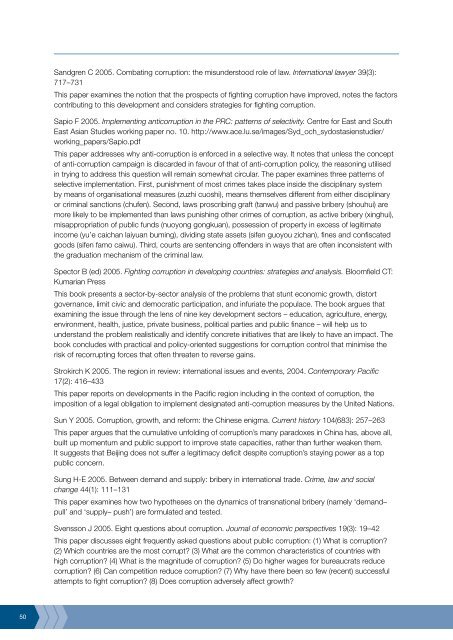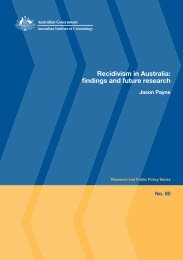Review of anti-corruption strategies Rob McCusker - Australian ...
Review of anti-corruption strategies Rob McCusker - Australian ...
Review of anti-corruption strategies Rob McCusker - Australian ...
You also want an ePaper? Increase the reach of your titles
YUMPU automatically turns print PDFs into web optimized ePapers that Google loves.
0<br />
Sandgren C 2005. Combating <strong>corruption</strong>: the misunderstood role <strong>of</strong> law. International lawyer 39(3):<br />
717–731<br />
This paper examines the notion that the prospects <strong>of</strong> fighting <strong>corruption</strong> have improved, notes the factors<br />
contributing to this development and considers <strong>strategies</strong> for fighting <strong>corruption</strong>.<br />
Sapio F 2005. Implementing <strong>anti</strong><strong>corruption</strong> in the PRC: patterns <strong>of</strong> selectivity. Centre for East and South<br />
East Asian Studies working paper no. 10. http://www.ace.lu.se/images/Syd_och_sydostasienstudier/<br />
working_papers/Sapio.pdf<br />
This paper addresses why <strong>anti</strong>-<strong>corruption</strong> is enforced in a selective way. It notes that unless the concept<br />
<strong>of</strong> <strong>anti</strong>-<strong>corruption</strong> campaign is discarded in favour <strong>of</strong> that <strong>of</strong> <strong>anti</strong>-<strong>corruption</strong> policy, the reasoning utilised<br />
in trying to address this question will remain somewhat circular. The paper examines three patterns <strong>of</strong><br />
selective implementation. First, punishment <strong>of</strong> most crimes takes place inside the disciplinary system<br />
by means <strong>of</strong> organisational measures (zuzhi cuoshi), means themselves different from either disciplinary<br />
or criminal sanctions (chufen). Second, laws proscribing graft (tanwu) and passive bribery (shouhui) are<br />
more likely to be implemented than laws punishing other crimes <strong>of</strong> <strong>corruption</strong>, as active bribery (xinghui),<br />
misappropriation <strong>of</strong> public funds (nuoyong gongkuan), possession <strong>of</strong> property in excess <strong>of</strong> legitimate<br />
income (yu’e caichan laiyuan buming), dividing state assets (sifen guoyou zichan), fines and confiscated<br />
goods (sifen famo caiwu). Third, courts are sentencing <strong>of</strong>fenders in ways that are <strong>of</strong>ten inconsistent with<br />
the graduation mechanism <strong>of</strong> the criminal law.<br />
Spector B (ed) 2005. Fighting <strong>corruption</strong> in developing countries: <strong>strategies</strong> and analysis. Bloomfield CT:<br />
Kumarian Press<br />
This book presents a sector-by-sector analysis <strong>of</strong> the problems that stunt economic growth, distort<br />
governance, limit civic and democratic participation, and infuriate the populace. The book argues that<br />
examining the issue through the lens <strong>of</strong> nine key development sectors – education, agriculture, energy,<br />
environment, health, justice, private business, political parties and public finance – will help us to<br />
understand the problem realistically and identify concrete initiatives that are likely to have an impact. The<br />
book concludes with practical and policy-oriented suggestions for <strong>corruption</strong> control that minimise the<br />
risk <strong>of</strong> recorrupting forces that <strong>of</strong>ten threaten to reverse gains.<br />
Strokirch K 2005. The region in review: international issues and events, 2004. Contemporary Pacific<br />
17(2): 416–433<br />
This paper reports on developments in the Pacific region including in the context <strong>of</strong> <strong>corruption</strong>, the<br />
imposition <strong>of</strong> a legal obligation to implement designated <strong>anti</strong>-<strong>corruption</strong> measures by the United Nations.<br />
Sun Y 2005. Corruption, growth, and reform: the Chinese enigma. Current history 104(683): 257–263<br />
This paper argues that the cumulative unfolding <strong>of</strong> <strong>corruption</strong>’s many paradoxes in China has, above all,<br />
built up momentum and public support to improve state capacities, rather than further weaken them.<br />
It suggests that Beijing does not suffer a legitimacy deficit despite <strong>corruption</strong>’s staying power as a top<br />
public concern.<br />
Sung H-E 2005. Between demand and supply: bribery in international trade. Crime, law and social<br />
change 44(1): 111–131<br />
This paper examines how two hypotheses on the dynamics <strong>of</strong> transnational bribery (namely ‘demand–<br />
pull’ and ‘supply– push’) are formulated and tested.<br />
Svensson J 2005. Eight questions about <strong>corruption</strong>. Journal <strong>of</strong> economic perspectives 19(3): 19–42<br />
This paper discusses eight frequently asked questions about public <strong>corruption</strong>: (1) What is <strong>corruption</strong>?<br />
(2) Which countries are the most corrupt? (3) What are the common characteristics <strong>of</strong> countries with<br />
high <strong>corruption</strong>? (4) What is the magnitude <strong>of</strong> <strong>corruption</strong>? (5) Do higher wages for bureaucrats reduce<br />
<strong>corruption</strong>? (6) Can competition reduce <strong>corruption</strong>? (7) Why have there been so few (recent) successful<br />
attempts to fight <strong>corruption</strong>? (8) Does <strong>corruption</strong> adversely affect growth?















